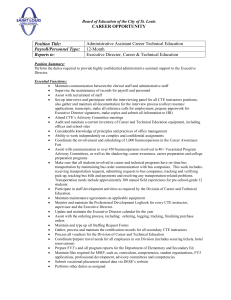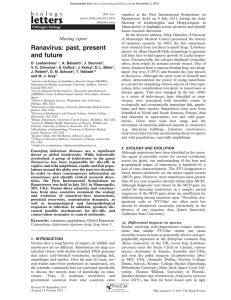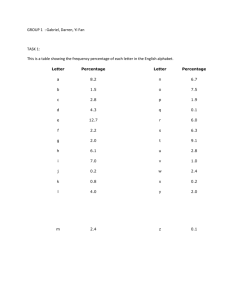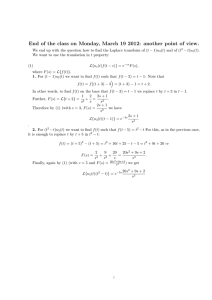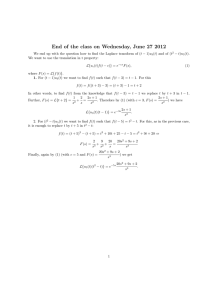Noninverting operational amplifier We see that Vo(s) = A(V (s) − V 1
advertisement
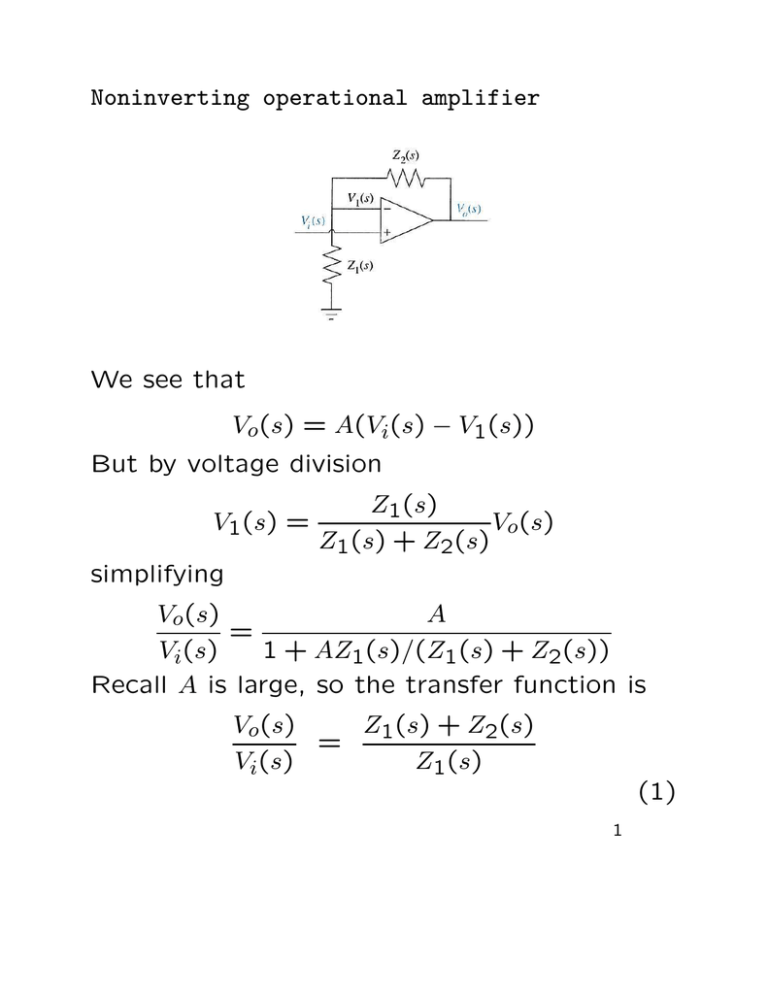
Noninverting operational amplifier We see that Vo(s) = A(Vi(s) − V1(s)) But by voltage division V1(s) = Z1(s) Vo(s) Z1(s) + Z2(s) simplifying A Vo (s) = Vi (s) 1 + AZ1(s)/(Z1 (s) + Z2(s)) Recall A is large, so the transfer function is Vo(s) Z1(s) + Z2(s) = Vi (s) Z1(s) (1) 1 (s) Example: Find the transfer function, VVo(s) , for i the circuit given below 2 Solution: The transfer function of the circuit is given by (1). Z1(s) = 1 1 + R1C1s + R1 = C1s C1s (2) For Z2(s), the admittances (reciprocal of the impedances) add, followed by taking the reciprocal of the sum 1 Z2(s) = 1 R + C2s 2 R2 = R2C2s + 1 (3) The transfer function is = Vo(s) Z1(s) + Z2 (s) = Vi(s) Z1 (s) C2C1 R2 R1s2 + (C2 R2 + C1R2 + C1 R1)s + 1 C2C1 R2 R1s2 + (C2R2 + C1 R1)s + 1 3 (s) Example: Find the transfer function, VVo(s) , for i the circuit given below 4 Solution: 1 3 Z1(s) = 200 × 10 + = 1 + 10−6s 500×103 s+7 × 105 1 + 0.5s 1 3 Z2(s) = 500 × 10 + 1 + 10−6s 100×103 0.5s + 6 × 105 1 + 0.1s The transfer function is = = Vo(s) Z1(s) + Z2(s) = Vi(s) Z1(s) 3.5s2 + 52s + 130 s2 + 17s + 70 5 Mechanical system transfer functions Transfer function – one equation of motion Problem: Find the transfer function, X(s)/F (s), for the system below. Solution: Begin the solution by drawing the free body diagram shown in Figure (a). Place on the mass all forces felt by the mass. 6 Only the applied force points to the right. All other forces impede the motion and act to oppose it. Hence the spring, viscous damper, and force due to acceleration point to the left. Using Newton’s law d2x(t) dx(t) M + fv + Kx(t) = f (t) 2 dt dt Taking Laplace transform, assuming zero initial conditions, M s2X(s) + fv sX(s) + KX(s) = F (s) 7 Solving for the transfer function yields G(s) = X(s) 1 = F (s) M s2 + fv s + K Can we circumventing the writing of differential equations by defining impedances for mechanical components? Yes. For the spring F (s) = KX(s) For the viscous damper F (s) = fv sX(s) For the mass F (s) = M s2X(s) Replace each force in Figure (a) we obtain Figure (b) 8 Transfer function – two degrees of freedom Problem: Find the transfer function, X2(s)/F (s), for the system below. Solution: The system has two degrees of freedom, since each mass can be moved in the horizontal direction while the other is held still. Thus two simultaneous equations of motion will be required to describe the system, each of which comes from the free body diagrams of each mass. 9 M1 : (a) Forces on M1 due only to motion of M1; (a) Forces on M1 due only to motion of M2; (a) All forces on M1. 10 M2 : (a) Forces on M2 due only to motion of M2; (a) Forces on M2 due only to motion of M2; (a) All forces on M2. 11 The Laplace transform of the equations of motion can be rewritten as [M1 s2 + (fv1 + fv3 )s + (K1 + K2 )]X1 (s) − [fv3 s + K2]X2 (s) = F (s) −[fv3 s + K2 ]X1 (s) + [M2 s2 + (fv2 + fv3 )s + (K2 + K3 )]X2 (s) = 0 From this, the transfer function, X2(s)/F (s), is X2(s) fv3 s + K2 G(s) = = F (s) △ where △ equals to [M1 s2 + (fv1 + fv3 )s + (K1 + K2 )] −[fv3 s + K2 ] [M2 s2 −[fv3 s + K2 ] + (fv2 + fv3 )s + (K2 + K3 )] For example, if M1 = 1kg, M2 = 2kg, fv1 = fv2 = fv3 = 1N − s/m, K1 = 1N/m, K2 = 2N/m, K3 = 3N/m, △= s2 + 2s + 3 −(s + 2) −(s + 2) = 2s4 + 6s3 + 20s2 + 20s + 19 (2s2 + 2s + 5) Thus s+2 G(s) = 4 2s + 6s3 + 20s2 + 20s + 19 12

